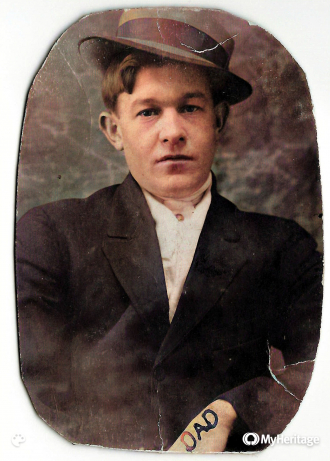Julius Joseph Prang
Julius Martinus Pranga
Julius Prang was born November 3, 1883 near the City of Gydnia (German: Gdingen) in the former German province of West Prussia, in the German Empire. He was the fourth child of twelve born to Joseph Jacob Pranga and Franciscka Marie Plotzke.
He was baptized in a Catholic Church in Oxhöft (Polish: Oksywie, Kashubian: Òksëwiô) on November 8, 1883 according to Germany, Select Births and Baptisms, 1558-1898, which records his name as “Julius Martinus Pranga.” It is unclear about when and why he was later known as Julius Joseph.
The Pranga’s and Plotzke’s lived in the region that was in the Kingdom of Prussia, the leading kingdom of the German Empire. Their home was in the province of West Prussia which included the traditional region of Pomerania, which today includes northwest Poland and northeast Germany following the coast along the Baltic Sea.
The Pranga family were ethnic Kashubians and part of a historic Slavic ethnic minority that had occupied the area for over 1000 years. The Kashubians spoke the last surviving of what had once included five separate Baltic languages of peoples who originally lived in this region along the Baltic Sea; four of those languages are now extinct. To an untrained ear, the Kashubian language sounds like Polish, but Polish speakers are generally unable to decipher Kashubian.
The late 1800s was a time of significant immigration from Poland. Poland had ceased to exist as an independent nation since 1795 when Russia, Germany, and Austria carved it up in what was known as the Third Partition.
Under the Prussian and German occupation, Poland saw a significant migration of Germans to the area who acquired much of the best land. The German authorities pursued a policy of Germanization, requiring all official business to be conducted in German, while they suppressed the Polish and Kashubian language and culture. Moreover, the German government under Chancellor Otto von Bismarck was decidedly anti-Catholic, another obstacle for the predominantly Catholic Polish and Kashubian communities.
Economic factors also contributed to mass migration. The region does not have very good soil for agriculture, and the fact that Kashubian and Polish families were Catholic, who tended to have large families during this time period, led to poor land being divided into smaller and smaller parcels, creating hardship to farmers. Additionally, the population was growing faster than the number of jobs available.
In 1887, the Pranga’s were living in Johannisdorf (today called Rumia Janowo) at about 115 Sobieskiego Street, 84-230, close to Julius’ place of baptism, Oxhöft. The area today is part of the metropolitan area of the Polish City of Gdynia, located just north of Gdansk (formerly Danzig). They apparently were impacted by the difficult economics of the time and made the decision to immigrate to America. Not all of Joseph Pranga’s family immigrated; some remained behind. However, most of Franciscka’s siblings moved about the same time.
According to Volume 55 of German's to America List, Jul 1887 to Apr 1888, Joseph Pranga departed alone on the ship “England” from Liverpool to New York, arriving on November 2, 1887. Franciscka traveled from Bremen to Baltimore seven months later on a ship called the “Rhein” that arrived on May 9, 1888. It was common for a husband to travel ahead of the family in order to find lodgings and employment before moving the family.
Volume 56 of German’s to America List, May 1888 to Nov 1888, record a Franz Pranga, age 29 traveling with four children, Johann, age 6, Marie, age 3, Julius, age 1, and Juliane, age 11 months. The record lists the children’s names correctly, and the order of their birth, but their ages do not match with their actual years of birth, as Julius would have been about 4 ½ years old at the time.
The Midwest American cities of Chicago, Detroit and Cleveland were primary destinations for immigrants from Poland and Kashubia, and the Pranga’s and Plotzke’s headed to Detroit. They settled on the east side of Detroit in a Polish enclave situated around St. Albertus Catholic Church and adjacent to the Polish immigrant dominated City of Hamtramck and the Detroit neighborhood of Poletown.
Joseph and Franciscka Pranga had seven more children after arriving in the United States. It is probable that Julius and his siblings were raised in a home where Kashubian was the primary language. Family stories suggest that Joseph never became fluent in English, even after living in American for more than 50 years. Because the Kashubes in Europe lived amongst the majority Poles and culturally dominant Germans, it is possible that they spoke Polish and German as well. The Pranga siblings often spoke Kashubian among themselves, even as adults.
On September 19, 1910, Julius married Helen Barbara Okon, the youngest child of Kashubian immigrants Joseph Okon and Julianna Franciscka Skwiercz. Helen was born on June 30, 1892 in Detroit. Her parents immigrated from the Kashubian coastal village of Putzig (today know as Puck), although she and all of her siblings were born in the United States. Like the Pranga children, it’s likely that she and her siblings were raised in a home where English was not the primary language. Family stories suggest that she also had some knowledge of Polish and German.
Helen was 18 at the time of their wedding. She had worked as a cigar roller, although it is unclear if that was a pre or post marriage avocation. Cigar rolling was a common job for women in those days as they could do the work from home.
Julius and Helen were married at St. Albertus Church on St. Aubin Street in Detroit. Their first child, Irene, was born the following October, but she survived only twelve days. Clara was born a year later, becoming the oldest of eleven children; seven girls and three boys.
Julius was required to register for the draft during World War I. He was listed as a “non-declarant alien,” indicating that he had not yet taken steps to become a U.S. Citizen. However, at 34 years of age when the war began in 1917, he was not drafted.
Julius and Helen may have moved into their house 11429 8 Mile Road in Warren sometime after the War, as they were recorded as living on St. Aubin Street at Lafayette in Detroit in 1918. However, they purchased the home in Warren in January 1930. The house was moved twice to make way for the widening of 8 Mile Road. It is still there today (2020).
Between 1911 and 1934, Julius and Helen had twelve children, of which eleven survived: Clara, 1912 (Stanley Zagaiski), Helen, 1914 (Edward LaCount), Florence, 1915 (Paul Dorsch [Dorschinski]), Grace, 1918 (Anthony J Barone), Clarence - “Sonny or Johnny,” 1920 (Lois Voss), Jerome – “Bud,” 1922 (Eleanor Upton), Frances – “Toots,” 1925 (Theophil Filek), Mary, 1927 (George “Buck” Basela), George – “Junior,” 1929 (Beatrice Osantowski), Lorraine – “Babe,” 1932 (Kenneth Jerome), Donald John (Rita I. “Gene” Thompson). His children called him “Pa.”
It’s uncertain what type of work he did through the course of his life, but at the time of his death, he was a tool and die maker, a skilled trade that he likely spent many years learning. Had he survived longer, he would have been considered an essential worker during World War II and probably would have benefitted financially on behalf of his family, doing critical work for war munitions production. His last employer, Rotary Electric Steel Company, made hot metal for electric furnaces.
He alone among his brothers dropped the “a” at the end of the family name of “Pranga,” instead, he shortened it to “Prang.” His World War I draft registration records his name as “Julius Joe Pranga.” His son Don Prang said that he dropped the “a” when he became a U.S. citizen.
Julius and his family attended Ascension Catholic Church in Warren in Macomb County. His nickname was “Irish,” an unusual nickname for someone who was not even a little Irish. He liked to fish when he had the time.
His daughter Frances, called “Toots” by her siblings, told me a story about her Dad: she recalled him returning home from work one day, finding that some of his sisters were there visiting his wife Helen. There were apparently speaking to one another in Kashubian and directed some comments or questions to him in Kashube. He responded by telling them, “We don’t speak that anymore, we are Americans now.”
Julius’ mother Franciscka died of a fractured skull after being struck by an auto in Detroit in 1931, three years after her daughter Julianna died from complications following surgery. She was on her way to Mass at Saint Albertus Catholic Church. In 1933, Julius’ oldest brother John died. John and his parents are buried in unmarked graves at Mount Olivet Cemetery.
Julius died on September 20, 1940, the day following his 30th wedding anniversary. He was at work at the Rotary Electric at 21400 Mound Road in Warren, less than a mile from their home when he was struck by acute angina accompanied by acute gastritis and gastric ulcer. He was buried in a single grave at Mount Olivet Cemetery in Detroit.











